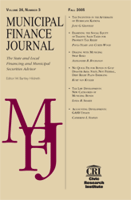Complete Issue
Author: W Bartley Hildreth.
Source: Volume 32, Number 03, Fall 2011 , pp.1-86(86)

< previous article |return to table of contents
Abstract:
Since the 1980s, the financial guarantee insurance business has been a mainstay of the municipal securities market, accounting for almost one-half of issuance volume. Armed with what was once considered a “depression-era stress-tested” triple-A credit standing, monoline bond insurers were nevertheless found to be extremely vulnerable to the subprime mortgage crisis due to their “wraps” around subprime mortgage-rated securities and credit default obligations. Although bond insurance is a negligible segment of today’s new-issuance market, insured bonds still carry their insurance wraps. To obtain an insurance wrap around a bond transaction, issuers of municipal securities pay an up-front premium. Professor of finance Earl D. Benson and accounting professor Barry R. Marks examine the determinants of premium differences for Texas general obligation bonds. After confirming that as an issuer’s risk increases, the premium increases, the researchers conclude that finance officers have factors under their control to reduce premium costs. That a bond insurer’s financial stability undergirds bond insurance is all the more clear after the subprime crisis. Finance professors Chris Brune and Pu Liu study an event in the (earlier) financial life of a major bond insurer to test the impact of market news on the risk premium of the municipal securities that it had wrapped with bond insurance. Their research finds that event news was impounded in a higher risk premium, but more so for revenue bonds than for general obligation bonds, and that there was a contagion effect on the broader municipal bond market. Issuers of insured municipal securities expect a lower borrowing cost to more than offset the cost of the insurance premium. Public administration professor Gao Liu studies the bonds issued by California jurisdictions to test the savings differences for the pre- and post-crisis periods. In addition to observing an interesting multiple-insurer phenomenon, the study finds that the market responded to the increased credit risks of insurers by decreasing interest savings prior to actual credit downgrade of the insurers. There are continuing efforts by some groups to resurrect the bond insurance market. As shown by these three articles, MFJ is open to analysts and researchers interested in delving into the bond insurance experience to offer additional insights into this long-running natural experiment. Only by documenting the behavior and impact of financial guarantors and their insurance products can we effectively learn from the past. Because local governments are creatures of their respective state governments, states can assert power over troubled local governments even to the point of taking them over or causing a financial restructuring of local affairs. Attorneys Harold S. Horwich and Seth J. Pruss review the concept of state-created local control boards. Their informed analysis offers professional guidance for policymakers faced with the prospect of having to intervene in local affairs.Keywords: Bond Insurance
Affiliations:
1: Municipal Finance Journal Editor, Georgia State University.